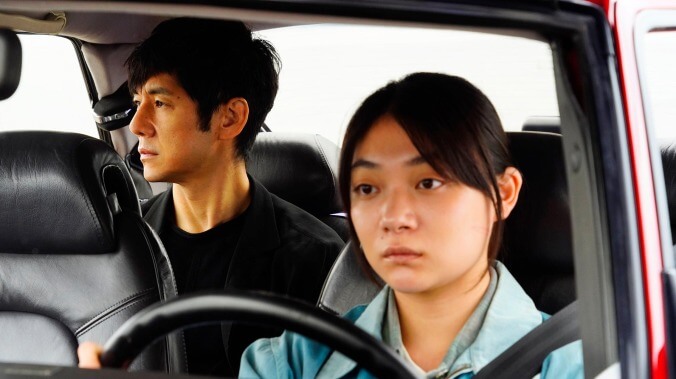Cannes winner Drive My Car is a hypnotic, beguiling portrait of life after loss
Ryusuke Hamaguchi's second film of 2021 revolves around an experimental production of Uncle Vanya


With Drive My Car, Ryusuke Hamaguchi joins a select group of filmmakers who have released two movies in one year—company that includes Steven Spielberg, Hong Sang-soo, and, mostly recently (and concurrently), Ridley Scott. Wheel Of Fortune And Fantasy, Hamaguchi’s first feature of 2021, was an anthology film comprised of three short segments involving missed and fraught connections. His second, Drive My Car, adapts a short story (this one by Haruki Murakami) into a three-hour melodrama.
Despite its mammoth running time, Drive My Car doesn’t spread its source material too thin. Instead, Hamaguchi expands what’s on the page into a patient meditation on life after loss, examining the unconventional ways damaged people embrace despair to hold onto cherished memories.
The main person in question here is theater actor/director Yûsuke Kafuku (Hidetoshi Nishijima), who loses his wife, Oto (Reika Kirishima), to a sudden cerebral hemorrhage. Kafuku and Oto’s relationship, which Hamaguchi establishes in a 40-minute prologue (punctuated by opening credits), is colored by plenty of domestic bliss and an active sex life. But a big secret and some unresolved tension also loom over it.
Two years following her death, Yûsuke is invited by a Hiroshima theater festival to stage an experimental, multilingual production of Anton Chekhov’s Uncle Vanya. The festival organizers put him up in fancy seaside digs an hour away from the theater—an arrangement Yûsuke requests, so he can listen to a cassette of Oto reciting the play, which she initially recorded to help him memorize lines. Unfortunately, he can’t listen to it alone because the festival demands that a driver shepherd him to and from his lodging for liability reasons. And so his daily routine gains an extra silent participant in the form of reserved 23-year-old chauffeur Misaki Watari (Tôko Miura).
As Yûsuke discovers, Misaki harbors her own unresolved grief. Driving is her coping mechanism, every bit as therapeutic as the tape he listens to on their commute. Like characters in the early films of Atom Egoyan, Yûsuke and Misaki project their sorrow onto mysterious rituals, experiencing grief through mediated, mechanical process. Yûsuke also actively seeks out situations that bring him closer to the memory of his wife, even if they’re uncomfortable. This includes his decision to cast a handsome, recently disgraced TV actor, Kôji Takatsuki (Masaki Okada), in the lead role of Vanya, partially because the younger performer had a flirtatious relationship with his late wife. What he doesn’t know is that Kôji sought out the production for the same reason, hoping that starring in the play would osmotically bring him closer to Oto.
Drive My Car frequently cuts between lengthy rehearsal scenes and Yûsuke in transit. Both serve subtle therapeutic functions. While those familiar with Uncle Vanya might appreciate certain choices, especially with relation to casting, Hamaguchi doesn’t stress explicit parallels between his film and Chekhov’s play. Instead, he emphasizes how any text will reflect a person’s inner psyche if they spend enough time with it. Even though he’s directing the production, Yûsuke keeps Uncle Vanya at a distance because he believes that if you yield yourself to Chekhov, it will dredge up real distress from your life. It’s both thematically appropriate and ironic that the actors in Yûsuke’s adaptation all speak different languages, including a woman who communicates in Korean Sign Language; the cast ultimately achieves a harmonious linguistic state, even as Yûsuke’s anguish remains lost in translation.
Meanwhile, the car itself becomes this contemplative space for Yûsuke and Misaki, separate from geography and time. Drive My Car’s tone and editing tempo evoke the hypnotizing, meditative effect of a lengthy road trip unmarred by rough terrain. (Eiko Ishibashi’s exceptional instrumental score also contributes there.) The film accumulates detail and incident until the barriers between each character start to crumble. Reflective surfaces and partitioned blocking emphasize the division between characters. As the car evolves from a place for introspection to a confessional booth, Hamaguchi underscores the intimacy that develops from open communication. A key emotional moment in Drive My Car arrives when Yûsuke moves from the back of the car to the passenger seat as he and Misaki become closely bonded.
In its final hour, Drive My Car begins to force and over-accentuate catharsis instead of letting it arise organically. Hamaguchi doesn’t exactly conceal the reasons for Yûsuke’s suffering or Misaki’s misfortune, but he disguises them just enough that they retain a certain amount of mystery. Nishijima and Miura, the two leads, are so adept at conveying their characters’ repressed emotions that when they eventually start professing their feelings aloud, Drive My Car loses some of its enigmatic power. Thee conclusions of their self-interrogation would probably feel less pat if they weren’t so neatly verbalized.
Still, Drive My Car effectively captures the double-edged nature of storytelling as a means of both processing and deflecting emotions; Uncle Vanya can be used to work through pain or to postpone it. Hamaguchi clearly recognizes film’s similar power. In Drive My Car, he asks his viewers to gaze into the characters’ passions and regrets without looking away. At one point late in the film, Hamaguchi briefly cuts out all sound and leaves an eerily quiet moving image. It’s almost as if he’s checking in with his audience’s resolve, testing their willingness to remain in the moment.